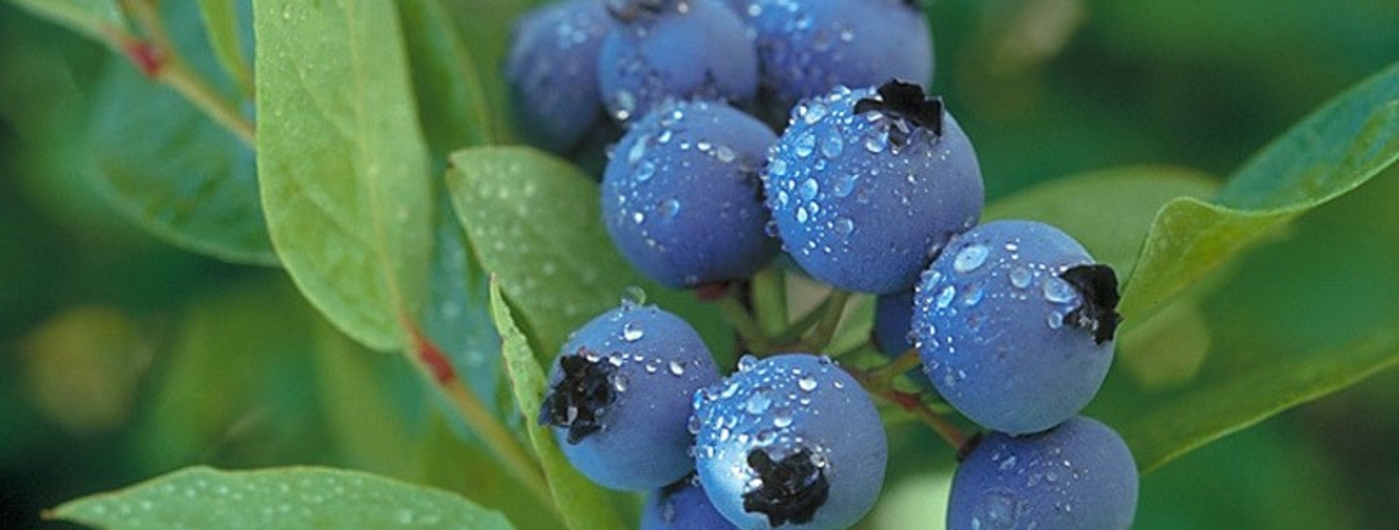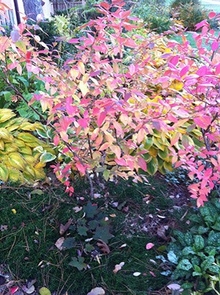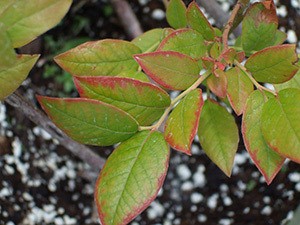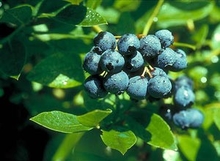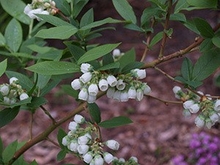Quick facts about growing blueberries
- Blueberries need full sun.
- Blueberries require acidic soil.
- Plant two or more varieties for successful pollination.
- Plants won't have much fruit the first 2 to 3 years.
- Harvest is bigger after 5 years.
- Blueberry plants grow slowly and reach full size in 8 to 10 years.
- Each winter, prune out old, weak and dead wood.
Many blueberry varieties grown in the Upper Midwest were bred for this climate by the University of Minnesota, making them right at home in the Minnesota home garden.
Blueberry plants grow slowly, and they may not seem to get much bigger from year to year. It takes a blueberry bush about 10 years to reach mature size, but this also means they will live a long, long time.
It will be 2 or 3 years before you start getting large harvests, but it is definitely worth the wait. The bushes are very attractive and will be a beautiful addition to your yard while you wait for fruit.
Care through the seasons
- March—Prune bushes before new growth begins, after coldest weather has passed.
- April, May—Plant new blueberry bushes.
- May, June—Apply mulch for growing season.
- July—Harvest.
- July through September—Apply soil amendments.
- September, October—Apply mulch for winter protection and enjoy fall color.
- November, December—Put fencing around plants to keep out rabbits.
Preparing to plant
Blueberry plants require acidic soil (pH 4.0 to 5.0) that is well-drained, loose and high in organic matter. Most garden soils in Minnesota have higher pH and must be amended.
If pH is too high:
- Growth of the plant is slowed.
- Leaves discolor.
- Plants may die.
Soil pH
Have your soil tested to determine pH.
Blueberries require a pH between 4.0-5.5. If the pH of the soil is over 5.5, then the soil is not acidic enough for blueberries.
Add an acidic soil amendment such as sulfur or sphagnum peat to the soil to lower the pH before planting. Sulfur is preferred, because the environmental consequences of sphagnum peat mining are becoming an increasing concern.
Using sulfur
It is best to amend the pH with sulfur the fall before planting, because it takes several months for sulfur to change the soil pH. To do this, add elemental sulfur to the soil in the planting area.
Elemental sulfur is widely available in garden stores. It may be marketed as soil acidifier or as soil sulfur/sulphur. The amount of sulfur to apply depends on the soil pH and soil type. To determine how much to apply, follow the product label.
Using sphagnum peat moss
Since sulfur takes months to alter the pH, gardeners wishing to plant immediately may need to create an acidic planting medium to plant into. Adding sphagnum peat can serve this purpose if the original pH is between 5.5-7.0.
- Add 4-6 inches of sphagnum peat to the top 6-8 inches of the soil in the area where the blueberries will be planted. This can be done by digging out the soil in the planting area, inserting the peat, and mixing part of the soil back in so that the planting area is a mixture of peat and soil. Please be mindful of the potential environmental impacts of peat mining.
- A soil with a pH closer to 7.0 will require more peat (5-6 inches) than a soil with a pH of 5.5-6.0 (4-5 inches).
- Amend the soil in the entire planting area, not just in the planting holes. The roots will expand outward, so amending the soil in a 2-3 foot wide strip is important to ensure the roots have access to acidic soil.
Since these are general guidelines, and every soil responds differently to inputs, submit another soil sample from the planting area about 6 months after planting. This will show whether the soil has reached the correct pH, or of more amendment is needed.
As the soil settles and decomposes over the years, you will need to continue adding sulfur to the planting bed.
Continue to have your soil pH tested every year or two, and amend as needed.
Do not use coffee grounds as a pH amendment
Coffee grounds are not always acidic and should not be relied upon as a pH amendment for blueberries. Even if the coffee grounds you use happen to be acidic, a massive amount would be needed to change the soil pH, and the results would not be reliable.
Fertilizer and mulch
If you see light-green or red leaves in the summer or not much shoot growth, it is likely that the soil pH is no longer in the optimum range of 4.0 to 5.0, or nitrogen is needed. Choose an organic acid fertilizer, such as one recommended for azaleas and rhododendrons.
Throughout the life of the plants, maintain a few inches of wood mulch around them.
Selecting plants
Blueberry plants are widely available at local and online nurseries. Be certain the plants you buy are winter hardy to your USDA zone (zone 3 or 4 in Minnesota).
If buying plants locally, find potted plants that are at least two or three years old.
If buying plants online, most likely they will arrive dormant and bare root. Order early to get the best selection.
Most nurseries ship bare root plants at the appropriate time for planting in early spring. Keep dormant plants in a dark, cool, moist place until you're ready to plant.
Make sure the roots stay moist but not saturated, and plant as soon as possible. Soak roots in a bucket of water for a couple of hours before planting.
If you buy plants at a local nursery, keep potted plants well-watered in a sunny location until planting and plant as soon as possible.
The University of Minnesota fruit breeding program has developed blueberry varieties that are perfectly suited to our climate. The varieties listed have been grown at U of M research farms in USDA zones 3 and 4. Recommendations are based on trial results.
Planting at least two varieties is best, as more berries of larger size will be produced if flowers are fertilized with pollen from another variety. Bumblebees and other native insects are enthusiastic pollinators of blueberries. The more insects working the plants, the more fruit you will harvest.
Region, weather and cultural practices may result in higher or lower yields.
University of Minnesota bred varieties are in bold and include the date of introduction. Average yield is based on data collected in east central Minnesota from mature plants, planted in full sun with other varieties, and watered regularly. Zone hardiness lists zone 4 first then zone 3.
Blueberry varieties for Minnesota
| Variety | Plant size (h x w) | Hardiness (zone 4 to 3) | Avg yield (lbs/bush) | Description |
|---|---|---|---|---|
| Bluecrop | 5 x 5 ft | Good to fair | 3 to 12 | Large, mild-sweet berries. Ripen mid-season |
| Chippewa (1996) | 4.5 x 5 ft | Excellent to good | 3 to 8 lbs | Medium-large, sky-blue berries. Firm texture, sweet flavor. Ripen mid-season. |
| Northblue (1983) | 3 x 4 ft | Excellent to good | 3 to 9 lbs | Large, dark blue, firm berries. Ripen mid-season. |
| Northcountry (1986) | 2.5 x 4 ft | Very good to fair | 3 to 5 lbs | Small-medium, sky-blue berries. Sweet, mild flavor. Ripen early. |
| Northland | 4 x 4 ft | Excellent to good | 3 to 12 lbs | Medium, mild flavored berries. Ripen mid-season. |
| Northsky (1983) | 2 x 3 ft | Good to fair | 1 to 5 lbs | Medium, sky-blue berries. Sweet and mild. Ripen mid-season. |
| Patriot | 4.5 x 4 ft | Good to fair | 3 to 12 lbs | Very large, tart berries. Ripen early. |
| Pink Popcorn™ (2014) | 4 x 4 ft | Very good to good | 3 to 5 lbs | Medium, cream to pink berries. Ripen early to mid-season. Self-pollinating. |
| Polaris (1996) | 4 x 4 ft | Very good to good | 3 to 8 lbs | Medium, firm, crisp berries. Intense flavor. Ripen early. |
| St. Cloud (1990) | 5 x 4 ft | Very good to good | 2 to 7 lbs | Medium, dark blue, firm berries. Sweet flavor, crisp texture. Ripen early. |
| Superior (2009) | 5 x 4 ft | Very good to good | 3 to 8 lbs | Medium, sweet-tart berries. Ripen late. |
Planting
Blueberries grow best in full sun. Plants will tolerate partial shade, but too much shade causes plants to produce fewer blossoms and less fruit.
Choose a sunny location
- Avoid areas surrounded by trees.
- Trees provide too much shade, compete with plants for water and nutrients, and interfere with air movement around plants.
- Poor air movement increases danger of spring frost injury to blossoms and favors disease development.
- Space blueberry plants about 3 feet apart. If the variety you purchase is listed as growing larger than that, then space them a little further apart.
- Plant young blueberry bushes in late April or early May.
- Dig the holes large enough to accommodate all the roots and deep enough so you can cover the uppermost roots with 3 to 4 inches of soil.
- Pack the soil firmly around the roots, then mulch the planting with 2 to 4 inches of sawdust, peat moss, oak leaf or pine needle mulch.
- These types of mulch are acidic and will help maintain a low soil pH.
- Mulch also helps maintain soil moisture, prevents weeds, and reduces soil temperature in the summer.
- Replenish mulch as needed.
- Water thoroughly after planting to ensure moisture reaches the deepest roots.
- Water the plant frequently and deeply, enough to keep the soil moist but not saturated.
Staking and support
Generally no support is required.
If a plant seems to be weak or growing at a non-vertical angle, a stake may be driven into the ground close to the main stem, and the stem gently tied to the stake with a wide tie such as those used for trees, or with a strip of fabric.
Do not use wire as it may cut into the stem.
Managing pests and diseases
Insects and wildlife cause minimal damage to blueberries. Because of the acidic soil requirements of blueberries, you are much more likely to have nutritional issues than pest issues. This highlights how important correct diagnosis is in addressing issues.
Find help identifying common pest problems:
- Use the online diagnostic tools What insect is this? and What's wrong with my plant?
- Send a sample to the UMN Plant Disease Diagnostic Clinic.
- Visit Ask a Master Gardener to share pictures and get advice.
Insects
Spotted wing drosophila is an invasive fruit fly that lays its eggs in ripe fruit, leading to soft, damaged berries.
The bright green and bronze colored Japanese beetle feeds on the leaves of blueberry plants, which can make them susceptible to winter injury.
Wildlife
In the late fall and winter, rabbits and deer enjoy nibbling on the stems of blueberry bushes. This may drastically stunt the plant. Protect plants by surrounding them with chicken wire or similar fencing in the fall and winter.
Diseases
Diseases are unlikely to cause significant problems on home grown blueberry plants.
Careful pruning will help prevent disease infection. Prune out and dispose of any part of the plant that is dead or dying.
For more information on disease and insect pests, see Pest management for home blueberry plants, Viruses of backyard fruit and Blueberry witches' broom.
Cankers
Examine the plants for cankers that first appear as small, discolored areas on the stems. As the affected areas enlarge, the margins remain reddish and the bark in the central part turns gray and then brown.
- Cankers usually occur close to the ground but may be higher on the stem.
- Stems are usually girdled in one season by cankers.
- Girdled stems die and leaves turn brown.
- Cut out affected parts several inches below the cankered area.
How to keep your blueberry bushes healthy and productive
Weeding and caring for young plants
In the first two years, remove flowers in the spring to encourage plant growth. This is necessary to ensure healthy, productive plants for years to come.
Production of flowers and fruits stunts growth when plants are too small or weak. A good-sized, healthy canopy is needed to support the fruit.
Blueberry plants grow slowly, which is one reason they live so long. The plants will put on plenty of fruit after the first few years, but don't be surprised if the plants stay small, as mature size is usually not reached until the plants are 8 to 10 years old.
Remove weeds regularly to keep your planting neat and clean and to prevent competition for water and nutrients. Mulch helps prevent weeds.
Nutrient-related challenges
Blueberry plants in soil with a pH above 5.5 will struggle to absorb the nutrients they need from the soil.
Signs of pH problems:
- Chlorosis, or yellow discoloring of the leaves, is usually the first sign of a soil pH problem.
- Slowed growth.
- Poor fruit production and general plant failure.
- Soil amendments don't work quickly enough to fix this in one season.
Spraying plants with a foliar chelated iron fertilizer, or spraying new leaves as they emerge, will temporarily green up the leaves, but it will not improve plant health in the long term.
Soil pH problems must be corrected to improve blueberry plant health. To amend soil pH:
- Keep the plants mulched with a few inches of oak leaf or pine needle mulch to help maintain soil acidity.
- Use a fertilizer that includes elemental sulfur, such as ammonium sulfate
Soil pH is easiest to amend with sulfur a year before the blueberries are planted. Do not plant blueberries until the soil is at the correct pH (4.5-5.5), or the plants may fail in the first year.
Test and monitor soil pH to stay ahead of this problem. Simple and inexpensive soil pH test kits are available online and at many garden centers. Or have your soil tested by the U of M Soil Testing Laboratory.
Pruning
At planting, prune only to remove any broken, dead or dying parts of branches. After the first year, prune the bushes annually in the early spring before growth starts.
Prune to:
- Remove dead and diseased wood.
- Shape the bush.
- Maintain enough vigorous main stems to prevent overbearing.
- Stimulate new shoot growth.
Fruit is produced on one-year-old wood. The largest berries are produced on the healthiest wood, so a good supply of strong, one-year-old wood is desirable.
- Keep the bush fairly open by cutting out any weak, old stems that no longer produce strong young wood.
- Remove these older stems at ground level.
- Keep four to six healthy older stems and one to two strong new shoots per mature bush. The new shoots will eventually replace the older stems.
- Take care not to prune too aggressively, as this can greatly reduce yield.
Harvest and storage
Harvest ripe fruit regularly
Berries will turn from green to blue and are ready for harvest when they're completely blue and are springy when gently squeezed.
- Taste a few berries that look ripe to get a good idea of how ripe fruit looks and feels.
- Fruit will ripen on one bush over a period of a couple weeks.
- Gently pull berries off the plant. Some stems might remain attached to the berries.
Place berries in a firm container in the refrigerator shortly after picking. Avoid layering berries more than a couple inches deep to prevent the lower berries from being damaged.
Do not wash berries until ready to eat. This will prevent them from molding in storage. Blueberries last longer in the refrigerator than many other berries. Generally, plan to use the berries within a week or so.
Blueberries freeze well
- For best freezing, wash berries and allow to dry.
- Lay dry berries in one layer on a baking sheet and place in freezer.
- Once the berries are frozen firm, place in an airtight container or freezer bag and return to freezer.
Chalker-Scott, Linda. Coffee grounds— will they perk up plants? Washington State University, MasterGardenerOnline.com, Winter 2009.
Mazerolle, Marc J. "Detrimental effects of peat mining on amphibian abundance and species richness in bogs," Biological Conservation, Volume 113, Issue 2, 2003, Pages 215-223, ISSN 0006-3207, https://doi.org/10.1016/S0006-3207(02)00360-9.
Strik, B.C. Growing Blueberries in Your Home Garden. Oregon State University Extension Service. EC 1304. Revised March 2008.
Pest management for home blueberry plants. University of Minnesota Extension. 2015.
Reviewed in 2024


